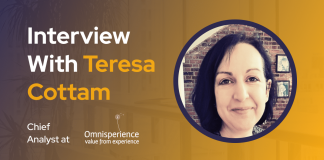Hi AJ, tell us about yourself and your background.
My name is AJ Triano. I am the EVP, CX Practice Lead at Syneos Health. My 15-year career in healthcare technology and communications focuses on innovation and customer experience in healthcare. I have worked within global healthcare agency networks, alongside Big Tech, and in small agile-based start-ups. I am motivated by a commitment to improving the way healthcare is researched, communicated, and delivered.
What is the biggest misunderstanding about customer experience, in your opinion?
The silver lining of the pandemic is that it has forced many companies to embrace the full potential of MarTech stacks. But there is a trap in play that causes many marketers to focus on the mechanics of MarTech and data flows for enablement, assuming that their current customer profiles and journey information is sufficient. That assumption sets up two misunderstandings that I am watching play out.
Misunderstanding #1 : Using omnichannel deployment inherently creates a tailored 1:1 customer experience. Marketers often point to omnichannel’s ability to create a journey using targeted and re-targeted content delivery with next-best-action logic as evidence. But these technical attributes of MarTech are only one-third of the equation.
Getting to two-thirds of an equation requires equal effort to be spent developing CX insights derived from a deeper understanding of the customer down to the nuanced personas in each segment and corresponding CX journeys. Unfortunately, I have seen many marketers skip this step thinking they know enough. But, they ultimately fail to speak with the stickiness that comes from a behavioral understanding of mindset. And, they often fail to continuously recalibrate the brand’s value to the changing needs and frictions that change a customer’s perception of the brand throughout the journey.
Completing the equation happens when using those CX insights to develop personae-specific mindset and channel-appropriate content strategies that enable a personalized brand experience when deployed in omnichannel journey designs.
Misunderstanding #2 : Being obsessed with a customer isn’t the same thing as customer-centricity. In healthcare, we have an intense focus on the customer, be it a patient or healthcare professional, often backed by corporate mission statements dedicated to improving patients’ lives and eradicating diseases. But being wonderfully obsessed with the patient is just the start. We need to push further by adopting the customer’s perspective looking back at the brand to figure out how the brand can be of relevant service along the journey instead of marketing at the customer.
To me, this is the difference between customer-focused and customer-centric marketing. I describe most healthcare brand marketing as being brand-centric and customer-focused. The marketing design typically takes a channel-obsessed approach that stays narrowly focused on transactions convenient to the brand marketer along the journey vs. working to understand the part of the customer experience that unfolds outside those transactions. These approaches typically enable typical multi-channel integrated marketing campaigns.
Instead, our opportunity is to develop a proper customer-centric understanding that enables an empathy-based omnichannel approach beyond today’s transactional focus. We can then create a motivational brand experience that delivers value beyond the product aligned with modern healthcare consumer expectations for a brand experience that is as valuable as its product.
What are some of the newer CX companies/solutions you’re keeping your eyes on right now?
There isn’t one platform or company in particular. Instead, I am most keen on solutions that help identify the customer’s experience and reveal the motivational “why” behind their decision-making.
AJ’s tips for improved customer loyalty
What can companies do to improve customer loyalty and retention?
First, embrace the customer experience expectation burden brought to your brand experience. Every customer has cost-of-entry expectations informed by other brand experiences both in and out of your vertical. This burden raises the bar, and brands can use it to drive deeper loyalty and advocacy.
Right now, the most significant influencer setting customer experience expectations is Amazon. As a result, customers want your brand to be accessible on their terms and time clock, immediately responsive with a customer service-focused posture, and ruthless pursuit of a simplified and anticipatory experience.
As brand leaders, we can create greater brand stickiness and motivational resonance by:
- Developing profiles across your key segment audiences including the following attributes: demographic, psychographic and motivational mindset, cultural influence, technographic, accessibility compliance, and some base level understanding of the customer experience expectation burden they bring to your brand.
- Push to create brand value beyond brand-centric transactional moments. These beyond-the-product experiences are incredibly effective at differentiating your brand and building loyalty. They may appear as opportunities that seem out of a typical marketers sphere of influence. But be bold. Go after opportunities that improve the customer experience using a “credible and addressable” rule of thumb. Will addressing the needs and frictions be addressable by the brand, lining up with strategic imperatives even if it feels out of the marketer’s comfort zone? Will the intervention or solution be credibly received by the customer as something they would accept from your brand vs. elsewhere?
- Consider just-in-time content programs designed to reduce friction and simplify information discovery by serving curated content that fits the persona in each moment of the journey.
What do you think is most relevant and why: CSAT (customer satisfaction score), NPS (net promoter score), or CES (customer effort score)?
Relevancy depends on what you are trying to measure. For example, CSAT is an excellent way to measure a brand interaction, such as satisfaction with a particular customer service call. On the other hand, NPS is a better measure of overall brand satisfaction that correlates with brand growth. Personally, I lean towards CES (2.0) because of the focus on measuring friction removal and better reflecting a customer-centric service mindset.
In reality, the best insights come from a combination of scoring methodologies. Of course, each of them has pros and cons. However, combination use provides a better actionable understanding of the experience. None of them sufficiently capture the “why,” in my opinion.
How can companies better use social media in the era of customer-centricity and personalization?
Brands have generally figured out where social platforms fit in their ecosystem for ad placement and brand engagement. Much has been made about targeting and re-targeting to enable tailored content delivery. However, privacy changes rolling out across state legislatures through tech giant policy and social pressure makes the use of data and targeting uncertain.
As a result, it is an excellent time to get back to an essential benefit of social media platforms as a source of insight into what customers think and feel to shape CX design. Too many brands do not allow time and budget to conduct regular social listening exercises to shape and refine strategies. Doing it once to shape the initial CX design is a good start. Continuing the listening as a part of impact measurement is crucial. Social listening should be a regular repeated cost of doing marketing business.
Crafting a sticky value proposition using social insights makes it easier to achieve first-person opt-in to continue delivering targeted and re-targeted media in a privacy-compliant way. Combining this effort with influencer engagement and personalized content will drive better results.
What is your opinion on AI-based chatbots to handle customer support?
I am a big fan of conversational marketing approaches, in general. A chatbot is not the only way to create conversational experiences. But, as a user interface, it is an excellent way to deliver on the customer experience expectation burdens mentioned earlier. It provides the ability to hyper-tailor the experience to the customer, including making information discovery easier. Some keys to success with AI-based chatbots include:
- Take the 80/20 rule for content development. Don’t go overboard with content. Instead, focus on the 20% of content that addresses 80% of customer need use cases.
- Enable the customer to bypass the nurturing process. If they are ready to buy, don’t keep forcing them through content! Get them to the action they want to take to convert.
- Have a warm transfer to a live person for the inevitable moment when the AI solution can’t help any further.
- Set reasonable expectations about how the AI bot can help.
- Create a personality and language design that is engaging and approachable. Drop the overly formal brand voice.
What was the best movie you saw that has come out during this past year?
We are reliving all the great Disney classics in our home. Our toddler, the pandemic, and on-demand entertainment have changed the fundamental idea of “screen time” in a beautiful way.
Last but not least, what is your favorite CX metric?
A trick question! I don’t have a favorite. A combination approach is likely best. But it all depends on the brand, the customer, and the situation.






